
Ayurveda is a 5,000-year-old system of natural healing that has its origins in the Vedic culture of India. Ayurveda is a science of life (Ayur = life,Veda = science or knowledge). It offers a body of wisdom designed to help people stay vital while realizing their full human potential. Providing guidelines on ideal daily and seasonal routines, diet, behavior and the proper use of our senses, Ayurveda reminds us that health is the balanced and dynamic integration between our environment, body, mind, and spirit.
Recognizing that human beings are part of nature, Ayurveda describes three fundamental energies that govern our inner and outer environments: movement, transformation, and structure. Known in Sanskrit as Vata (Wind), Pitta (Fire), and Kapha (Earth), these primary forces are responsible for the characteristics of our mind and body. Each of us has a unique proportion of these three forces that shapes our nature. If Vata is dominant in our system, we tend to be thin, light, enthusiastic, energetic, and changeable. If Pitta predominates in our nature, we tend to be intense, intelligent, and goal-oriented and we have a strong appetite for life. When Kapha prevails, we tend to be easy-going, methodical, and nurturing. Although each of us has all three forces, most people have one or two elements that predominate.
An important goal of Ayurveda is to identify a person’s ideal state of balance, determine where they are out of balance, and offer interventions using diet, herbs, aromatherapy, massage treatments, music, and meditation to reestablish balance.
Basic principles of Ayurveda:
– Ayurveda aims at the well being of everybody without any boundaries of a particular country,
– Ayurveda has no beginning & no end
– It has no religion bondage, age, rase
– It does not belong to particular period of history i.e. it is existing since the birth of life on earth.
The ancient Ayurvedic system was astoundingly complete. In the colleges of ancient India, students could choose a specialty from eight branches of medicine.
1, Internal Medicine (KAyachikitsA) – this is related to the soul, mind, and body. Psychosomatic theory recognizes that the mind can create illness in the body and vice versa. The seven body constitutions and seven mental constitutions were delineated here.
2. Ears, Nose, and Throat – Ayurveda reveals approximately 72 eye diseases, surgical procedures for all eye disorders (e.g., cataracts, eyelid diseases), and for diseases of the ears, nose, and throat.
3. Toxicology – Topics include air and water pollution, toxins in animals, minerals, vegetables, and epidemics; as well as keys for recognizing these anomalies and their antidotes.
4. Pediatrics – In this branch prenatal and postnatal care of the baby and mother are discussed.
5. Surgery – More than 2,000 years ago, sophisticated methods of surgery were known.
6. Psychiatry – A whole branch of Ayurveda specifically deals with diseases of the mind (including demonic possession). Besides herbs and diet, yogic therapies (breathing, mantras, etc.) are employed.
7. Aphrodisiacs – This section deals with two aspects: infertility (for those hoping to conceive) and spiritual development (for those eager to transmute sexual energy into spiritual energy).
8. Rejuvenation (RasAyana).- Prevention and longevity are discussed in this branch of Ayurveda.
According to ayurveda and yoga , there are four aims of life:
* Artha – prosperity, wealth – whatever activity and physical material a man needs to support life can be considered as artha
* Kama – pleasure, sensual gratification , happiness, natural instinct, relationships and material objects like food, drink etc.
* Dharma – duty, ethics -man has obligation to his own self, to the fellow-men and to the society, in fact, to the whole environment of
the world
* Moksha – the pursuit of liberation, total freedom, to emancipate or to release or to free. Indian tradition considers moksha as the ultimate goal of life.
Ayurveda also prescribes personal and social hygiene, daily and nightly routines, seasonal regimes, healthy cooking recipies, yoga and exercises, meditation and mental relaxation, spiritual development and other simple practices necessary for the maintenance of health and prevention of diseases.
Ayurveda shows man how to remove pain, sufferings and natural turbulences and to restore happiness, peace and ecological balance through various devices, measures and systems. A great deal of stress is laid on psychosomatic and spiritual treatment – a combination, which may be called a super-holistic approach.